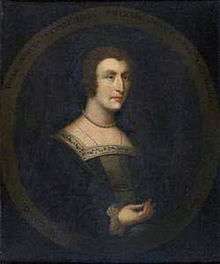Janet Stewart, Lady Fleming
Janet Stewart, Lady Fleming (17 July 1502 – 20 February 1562), called la Belle Écossaise (French for 'the Beautiful Scotswoman'), was an illegitimate daughter of King James IV of Scotland who served as governess to her half-niece Mary, Queen of Scots. Janet was briefly a mistress of King Henry II of France, by whom she had a legitimated son: Henri d'Angoulême.[1] Her daughter, Mary Fleming, was one of the young queen's "Four Marys".

Family
Janet Stewart (also referred to as Jane, Jenny, and other variants) was the eighth known bastard of the Stewart king James IV. Her half-brothers included James Stewart, 1st Earl of Moray; Alexander Stewart, Lord Chancellor of Scotland; and James V, King of Scots, her father's only surviving legitimate child.
Her mother—the fourth royal mistress of James IV to bear his offspring—was Isabel, daughter of James Stewart, 1st Earl of Buchan (who bore the nickname "Hearty James").[2] Janet's parents were distantly related (precisely, half second cousins once removed) by a common ancestor: Joan Beaufort, Queen of Scots.
Marriage and issue
Janet Stewart married Malcolm Fleming, 3rd Lord Fleming, despite being related within a forbidden degree of affinity. They had eight children:
- Johanna (born 1525)
- Janet (born 1527), who was first married to John, Master of Livingston, killed at the battle of Pinkie 1547, eldest son of Alexander Livingston, 5th Lord Livingston, and a brother of Mary Livingston, one of Queen Mary's "Four Marys"
- Margaret Fleming (born by 1532), who married Robert Graham, Master of Montrose, by whom she had a son, John Graham, 3rd Earl of Montrose; then was remarried to Thomas Erskine, Master of Erskine (younger brother of the John Erskine, 6th Lord Erskine), but had no issue; and thirdly, married John Stewart, 4th Earl of Atholl, by whom she had a son John Stewart, 5th Earl of Atholl and three daughters. Margaret Fleming was said to be a witch possessing the power to cast spells.[3]
- James Fleming, 4th Lord Fleming (?born 1534), his daughter Jean Fleming (1554–1609) married John Maitland, the younger brother of William Maitland—his sister Mary Fleming's husband. His grandson by Jean was John Maitland, 1st Earl of Lauderdale.
- Elizabeth (born 1530)
- John Fleming, 5th Lord Fleming (?born 1535).
- Agnes (born 1535), who married William Livingstone, 6th Lord Livingston
- Mary Fleming (born 1543), was one of the "Four Marys" the ladies in waiting to Mary, Queen of Scots who married William Maitland of Lethington
Court life
Lord Fleming was killed at the Battle of Pinkie in 1547. The following year, presumably due to her unofficial membership in the royal Stewart family, the widow Fleming was appointed governess or nurse to her infant half-niece Mary, Queen of Scots (her new mistress having been fathered by her late half-brother). Her own daughter, Mary Fleming, also joined the queen's household as a lady-in-waiting.
In 1548, mother and daughter accompanied the young queen to France. The Bishop of Orkney, Robert Reid, expressed worry over the lady's lack of French; as Janet was only fluent in Scots, he questioned her ability to communicate to French doctors any potential symptoms of illness seen in Mary.[4] At the royal court of France, the lady Janet soon attracted the attentions of King Henry II and became his lover. Their affair resulted in pregnancy, and—either before or after bearing the French monarch an illegitimate son—Janet was sent back to Scotland and replaced as governess to Mary by Françoise de Paroy. Her boy, called Henri de Valois-Angoulême (1551–June, 1586), was "the chief and most highly favored natural son of the King". He was legitimized and went on to become the "Grand Prior of France, Governor of Provence, and Admiral of the Levantine Sea."[5]
In November 1549 the English prisoner James Wilford was exchanged for the release of her son James Lord Fleming who had been captured during the war of the Rough Wooing.[6] In October 1552, Janet's situation in Scotland was described by Mary of Guise in a letter written to her brother, the Cardinal of Lorraine. There had been talk of marrying Janet off to Henri Cleutin, Guise's military advisor. Although one of Janet's daughters had informed Mary of Guise that her mother did not wish to leave Scotland, Guise knew that Janet had discussed leaving Scotland with the Governor, Regent Arran, and wanted to see Henry II that winter. Guise told the Cardinal to reassure Catherine de' Medici, the queen of France, that Janet would not be leaving Scotland.[7]
Janet was one of the ladies who kept vigil over the body of Mary of Guise at Edinburgh Castle in June 1560. The ladies were not at first given mourning clothes, and Janet quoted in Latin a phrase from the Book of Joel to the English diplomat Thomas Randolph, "Scindite corda vestra, non vestimenta," Rend your heart, not your garments.[8] Afterwards, Janet applied to the Privy Council for permission to leave Scotland with her son "Lord Hary de Valoys" on 22 August 1560. Henry took part in the St. Bartholomew's Day massacre and was killed in a duel in 1586.[9]
References
- Robert J. Sealy, The Palace Academy of Henry III, (Droz, 1981), 206.
- Norman MacDougall, James IV of Scotland
- Weir 2004, p. 43.
- Pollen, John Hungerford, ed., Papal Negotiations of Mary Queen of Scots, SHS (1901), p.414, Reid to Giovanni Ferreri, 26 December 1548.
- Riddell 1843, pp. 47-51.
- HMC Manuscripts of the Duke of Rutland, vol. 4 (London, 1905), pp. 194-197.
- Calendar State Papers Spain, vol.10 (London, 1914), p. 588.
- Calendar State Papers Scotland, vol. 1 (Edinburgh, 1898), p. 429, (Joel. ii. 13)
- Riddell 1843, pp. 49-50 (citing a transcript of the Privy Council record in the Cotton library).
Sources
- Riddell, John (1843). Stewartiana at Google Books. Edinburgh.
- Weir, Alison (2004). Mary, Queen of Scots, and the Murder of Lord Darnley at Google Books. New York: Random House Trade Paperbacks.